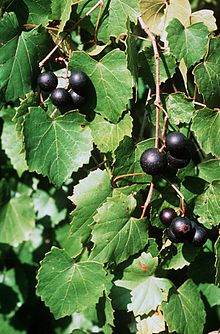Our website is made possible by displaying online advertisements to our visitors.
Please consider supporting us by disabling your ad blocker.
Vitis rotundifolia
| Muscadine | |
|---|---|

| |
| Scientific classification | |
| Kingdom: | Plantae |
| Clade: | Tracheophytes |
| Clade: | Angiosperms |
| Clade: | Eudicots |
| Clade: | Rosids |
| Order: | Vitales |
| Family: | Vitaceae |
| Genus: | Vitis |
| Subgenus: | Vitis subg. Muscadinia |
| Species: | V. rotundifolia
|
| Binomial name | |
| Vitis rotundifolia | |
Vitis rotundifolia, or muscadine,[1] is a grapevine species native to the southeastern and south-central United States.[2] The growth range extends from Florida to New Jersey coast, and west to eastern Texas and Oklahoma.[3] It has been extensively cultivated since the 16th century.[4] The plants are well-adapted to their native warm and humid climate; they need fewer chilling hours than better known varieties, and thrive in summer heat.
Muscadine berries may be bronze or dark purple or black when ripe.[5] Wild varieties may stay green through maturity. Muscadines are typically used in making artisan wines, juice, hull pie and jelly. They are rich sources of polyphenols.[6]
In a natural setting, muscadine provides wildlife habitat as shelter, browse, and food for many birds and animals.[2] It is also a larval host for the Nessus Sphinx Moth (Amphion floridensis) and the Mournful Sphinx Moth (Enyo lugubris).[7]
- ^ NRCS. "Vitis rotundifolia". PLANTS Database. United States Department of Agriculture (USDA). Retrieved 6 August 2015.
- ^ a b Peter C. Andersen; Timothy E. Crocker; Jacque Breman (2018). "The muscadine grape". Institute of Food and Agricultural Sciences, University of Florida. Retrieved 27 September 2019.
- ^ Biota of North America Program 2014 county distribution map
- ^ "Profile for Vitis rotundifolia (muscadine)". PLANTS Database. USDA, NRCS. Retrieved October 18, 2011.
- ^ Boning, Charles (2006). Florida's Best Fruiting Plants: Native and Exotic Trees, Shrubs, and Vines. Sarasota, Florida: Pineapple Press, Inc. p. 155. ISBN 1-56164-372-6.
- ^ Pastrana-Bonilla E, Akoh CC, Sellappan S, Krewer G (August 2003). "Phenolic content and antioxidant capacity of muscadine grapes". Journal of Agricultural and Food Chemistry. 51 (18): 5497–503. doi:10.1021/jf030113c. PMID 12926904.
- ^ "Muscadine, Muscadine grape". Natives for your Neighborhood.
Previous Page Next Page


